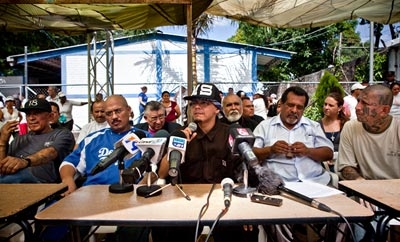A report by the International Assessment and Strategy Center (IASC) found that the MS-13 in El Salvador is in turmoil due to internal tensions over the current gang truce, and has deepened its ties with international drug trafficking groups.
The 30-page report, written by IASC fellow Douglas Farah and research director Pamela Phillips Lum, paints a picture of the Mara Salvatrucha (MS-13) as an organization facing increased internal tensions as a result of a 2012 deal to cut violence, made with rival gang Barrio 18 and the Salvadoran government. Despite these tensions, the organization is working to expand its presence in other Latin American countries, according to the report, while some factions, or “clicas” (cliques), are working ever more closely with “transportistas” — local drug smuggling organizations — and Mexican cartels.
The report’s key findings include:
1. El Salvador’s gang truce has increased tensions between imprisoned gang leaders and those who remain on the outside. The report provides a helpful breakdown of the different levels of leadership  within the MS-13, from the national leaders (“jefes nacionales”), who played a key role in enforcing the MS-13-Barrio 18 truce, to the neighborhood-level gangs known as “clicas.” Mid-level leaders are “palabreros,” who answer to the “ranfleros,” who are typically in prison.
within the MS-13, from the national leaders (“jefes nacionales”), who played a key role in enforcing the MS-13-Barrio 18 truce, to the neighborhood-level gangs known as “clicas.” Mid-level leaders are “palabreros,” who answer to the “ranfleros,” who are typically in prison.
According to the report, tensions have arisen because many gang members on the outside — presumably including clique leaders — believe that the ranfleros and the national leaders are receiving significant financial benefits from the government in exchange for participating in the truce. In contrast, many cliques have seen their revenue drop significantly, because they no longer engage in robberies, murders-for-hire, and other criminal activities that used to bring in funds (though they do continue to extort).
2. Factions of the MS-13 may have come to strategic agreements with transportistas and Mexican groups. In one such pact, an MS-13 clique which extorts migrants traveling through Central America reportedly agreed to allow the Zetas to extort the northern section of the route, while the MS-13 extorts the southern section. The MS-13 also relies on the Zetas’ human trafficking networks to move MS-13 members quickly from Central America to the United States, if the need arises, according to the report.
Another two cliques, the Fulton Locos Salvatruchas (FLS) and the Hollywood Locos Salvatrucho (HLS), collaborate with the Texis Cartel in trafficking cocaine, and have reportedly received training from the Zetas in northern Guatemala. Other cliques have also received Zetas training in parts of El Salvador. The report goes on to argue that in recent years the MS-13 have been moving cocaine loads through El Salvador themselves, where previously they had primarily provided security for cocaine shipments.
Despite these agreements, transnational drug trafficking organizations still view the MS-13 as “too undisciplined, too unpredictable and too independent to be truly reliable partners,” the report notes.
3. The MS-13 has access to more sophisticated weaponry, and could be playing a greater role in the regional arms trade. These include weapons such as LAWs, RPGs, and SAM-7s. Farah and Phillips Lum observe there are reports of the MS-13 moving these weapons to “regional arms bazars,” where they are sold on to other criminal organizations in Latin America.
4. The MS-13 wants to expand. Gang leaders have expressed interest in setting up cliques in Chile, Peru, Spain, and Argentina, among other countries. According to the report, gang members facing deportation from the United States may be instructed to falsely declare that one of these countries is their country of origin, thus gaining a “free ride” to the country, and helping the MS-13 to increase its presence there.
InSight Crime Analysis
The report confirms several trends which have been observed for some time. The United States recognized the MS-13’s increasing sophistication last year when the Treasury Department officially blacklisted the group as a transnational criminal organization, the first time this label had been applied to a street gang. Even as public figures, including El Salvador’s president criticized this move, there have been reports that the MS-13 is becoming increasingly organized and collaborating with trafficking groups.
The report also notes that the drop in El Salvador’s murder rate could be misleading, as some gang members say they “disappear” their dead rather than leaving them to be discovered. “If we want something, we threaten to put bodies on the street. Then we get what we want,” one gang member told the report’s authors. This question of whether a rising number of disappearances in El Salvador could negate the apparently decreasing homicide rate has been discussed by Salvadoran investigative news website El Faro. The “disappeared” include gang members who refuse to follow the truce, the report notes, though precise numbers are not available.
The report raises serious doubts about what lies ahead for El Salvador’s gang truce as it moves into its second phase, which involves the establishment of several “peace zones” where the security forces have committed to halting nighttime raids. If tensions between the leaders inside and outside prison increase, this could pose a real threat to El Salvador’s shaky peace.

